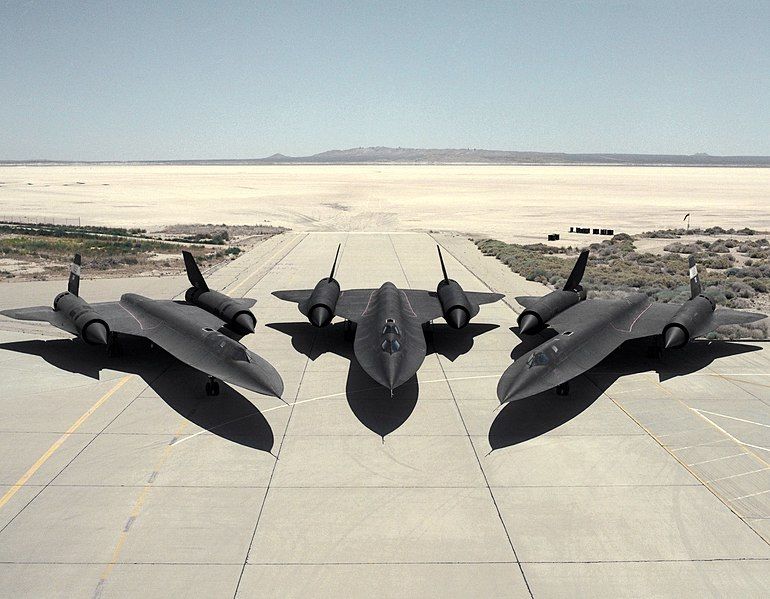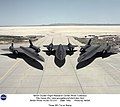File:Lockheed SR-71s.jpg

Original file (2,749 × 2,140 pixels, file size: 850 KB, MIME type: image/jpeg)
| This is a file from the Wikimedia Commons. Information from its description page there is shown below. Commons is a freely licensed media file repository. You can help. |
Summary
| DescriptionLockheed SR-71s.jpg |
English: Three SR-71s on Ramp
|
| Date | |
| Source | https://www.dfrc.nasa.gov/Gallery/Photo/SR-71/HTML/EC92-7013-4.html (direct link) |
| Author | NASA |
| Permission (Reusing this file) |
public domain, created by US government agency |
This image or video was catalogued by Armstrong Flight Research Center of the United States National Aeronautics and Space Administration (NASA) under Photo ID: EC92-7013-4. This tag does not indicate the copyright status of the attached work. A normal copyright tag is still required. See Commons:Licensing. Other languages:
العربية ∙ беларуская (тарашкевіца) ∙ български ∙ català ∙ čeština ∙ dansk ∙ Deutsch ∙ English ∙ español ∙ فارسی ∙ français ∙ galego ∙ magyar ∙ հայերեն ∙ Bahasa Indonesia ∙ italiano ∙ 日本語 ∙ македонски ∙ മലയാളം ∙ Nederlands ∙ polski ∙ português ∙ русский ∙ sicilianu ∙ slovenščina ∙ Türkçe ∙ українська ∙ 简体中文 ∙ 繁體中文 ∙ +/− |
Licensing
| Public domainPublic domainfalsefalse |
| This file is in the public domain in the United States because it was solely created by NASA. NASA copyright policy states that "NASA material is not protected by copyright unless noted". (See Template:PD-USGov, NASA copyright policy page or JPL Image Use Policy.) |  | |
 |
Warnings:
|
- You are free:
- to share – to copy, distribute and transmit the work
- to remix – to adapt the work
- Under the following conditions:
- attribution – You must give appropriate credit, provide a link to the license, and indicate if changes were made. You may do so in any reasonable manner, but not in any way that suggests the licensor endorses you or your use.
| This image, originally posted to Flickr, was reviewed on March 8, 2009 by the administrator or reviewer File Upload Bot (Magnus Manske), who confirmed that it was available on Flickr under the stated license on that date. |
Captions
Items portrayed in this file
depicts
some value
26 February 2009
File history
Click on a date/time to view the file as it appeared at that time.
| Date/Time | Thumbnail | Dimensions | User | Comment | |
|---|---|---|---|---|---|
| current | 08:48, 22 July 2022 |  | 2,749 × 2,140 (850 KB) | Denniss | Reverted to version as of 17:41, 8 March 2009 (UTC) |
| 08:48, 22 July 2022 |  | 3,000 × 2,670 (4.18 MB) | Denniss | Original file for reference | |
| 17:41, 8 March 2009 |  | 2,749 × 2,140 (850 KB) | File Upload Bot (Magnus Manske) | {{Information |Description= The Lockheed SR-71 was an advanced, long-range, Mach 3 strategic reconnaissance aircraft developed from the Lockheed A-12 and YF-12A aircraft by the Lockheed Skunk Works. The SR-71 was unofficially named the Blackbird, and cal |
File usage
The following page uses this file:
Global file usage
The following other wikis use this file:
- Usage on es.wikipedia.org
- Usage on fr.wikipedia.org
- Usage on he.wikipedia.org
- Usage on pt.wikipedia.org
Metadata
This file contains additional information, probably added from the digital camera or scanner used to create or digitize it.
If the file has been modified from its original state, some details may not fully reflect the modified file.
| JPEG file comment | NASA Dryden Flight Research Center Photo Collection
http://www.dfrc.nasa.gov/gallery/photo/index.html NASA Photo: EC92-7013-4 Date: 1992 Photo by: NASA Three SR-71s on Ramp The original trio of SR-71 "Blackbirds" loaned to NASA by the U.S. Air Force for high-speed, high-altitude research line the ramp at the Dryden Flight Research Center, Edwards, California. The three former reconnaissance aircraft, two SR-71 "A" models and one "B" model, can fly more than 2200 mph and at altitudes of over 80,000 feet. This operating environment makes the aircraft excellent platforms to carry out research and experiments in aerodynamics, propulsion, structures, thermal protection materials, atmospheric studies, and sonic boom characterization. One of the "A" models was later returned the Air Force for active duty. It subsequently returned to Dryden. Two SR-71 aircraft have been used by NASA as testbeds for high-speed and high-altitude aeronautical research. The aircraft, an SR-71A and an SR-71B pilot trainer aircraft, have been based here at NASA's Dryden Flight Research Center, Edwards, California. They were transferred to NASA after the U.S. Air Force program was cancelled. <p> As research platforms, the aircraft can cruise at Mach 3 for more than one hour. For thermal experiments, this can produce heat soak temperatures of over 600 degrees Fahrenheit (F). This operating environment makes these aircraft excellent platforms to carry out research and experiments in a variety of areas -- aerodynamics, propulsion, structures, thermal protection materials, high-speed and high-temperature instrumentation, atmospheric studies, and sonic boom characterization. <p> The SR-71 was used in a program to study ways of reducing sonic booms or over pressures that are heard on the ground, much like sharp thunderclaps, when an aircraft exceeds the speed of sound. Data from this Sonic Boom Mitigation Study could eventually lead to aircraft designs that would reduce the "peak" overpressures of sonic booms and minimize the startling affect they produce on the ground. <p> One of the first major experiments to be flown in the NASA SR-71 program was a laser air data collection system. It used laser light instead of air pressure to produce airspeed and attitude reference data, such as angle of attack and sideslip, which are normally obtained with small tubes and vanes extending into the airstream. <p> One of Dryden's SR-71s was used for the Linear Aerospike Rocket Engine, or LASRE Experiment. Another earlier project consisted of a series of flights using the SR-71 as a science camera platform for NASA's Jet Propulsion Laboratory in Pasadena, California. An upward-looking ultraviolet video camera placed in the SR-71’s nosebay studied a variety of celestial objects in wavelengths that are blocked to ground-based astronomers. <p> Earlier in its history, Dryden had a decade of past experience at sustained speeds above Mach 3. Two YF-12A aircraft and an SR-71 designated as a YF-12C were flown at the center between December 1969 and November 1979 in a joint NASA/USAF program to learn more about the capabilities and limitations of high-speed, high-altitude flight. The YF-12As were prototypes of a planned interceptor aircraft based on a design that later evolved into the SR-71 reconnaissance aircraft. Dave Lux was the NASA SR-71 project manger for much of the decade of the 1990s, followed by Steve Schmidt. <p> Developed for the USAF as reconnaissance aircraft more than 30 years ago, SR-71s are still the world's fastest and highest-flying production aircraft. The aircraft can fly at speeds of more than 2,200 miles per hour (Mach 3+, or more than three times the speed of sound) and at altitudes of over 85,000 feet. <p> The Lockheed Skunk Works (now Lockheed Martin) built the original SR-71 aircraft. Each aircraft is 107.4 feet long, has a wingspan of 55.6 feet, and is 18.5 feet high (from the ground to the top of the rudders, when parked). Gross takeoff weight is about 140,000 pounds, including a possible fuel weight of 80,280 pounds. The airframes are built almost entirely of titanium and titanium alloys to withstand heat generated by sustained Mach 3 flight. Aerodynamic control surfaces consist of all-moving vertical tail surfaces, ailerons on the outer wings, and elevators on the trailing edges between the engine exhaust nozzles. <p> The two SR-71s at Dryden have been assigned the following NASA tail numbers: NASA 844 (A model), military serial 61-7980 and NASA 831 (B model), military serial 61-7956. From 1990 through 1994, Dryden also had another "A" model, NASA 832, military serial 61-7971. This aircraft was returned to the USAF inventory and was the first aircraft reactivated for USAF reconnaissance purposes in 1995. It has since returned to Dryden along with SR-71A 61-7967. |
|---|---|
| Horizontal resolution | 72 dpi |
| Vertical resolution | 72 dpi |
| Software used | picnik.com |
| Y and C positioning | Centered |
